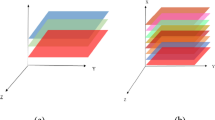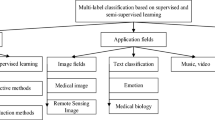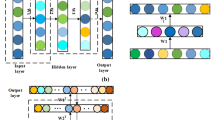Abstract
Increasing attention is being paid to the classification of ground objects using hyperspectral spectrometer images. A key challenge of most hyperspectral classifications is the cost of training samples. It is difficult to acquire enough effective marked label sets using classification model frameworks. In this paper, a semi-supervised classification framework of hyperspectral images is proposed to better solve problems associated with hyperspectral image classification. The proposed method is based on an iteration process, making full use of the small amount of labeled data in a sample set. In addition, a new unlabeled data trainer in the self-training semi-supervised learning framework is explored and implemented by estimating the fusion evidence entropy of unlabeled samples using the minimum trust evaluation and maximum uncertainty. Finally, we employ different machine learning classification methods to compare the classification performance of different hyperspectral images. The experimental results indicate that the proposed approach outperforms traditional state-of-the-art methods in terms of low classification errors and better classification charts using few labeled samples.










Similar content being viewed by others
References
Alajlan N, Bazi Y, Melgani F, Yager RR (2012) Fusion of supervised and unsupervised learning for improved classification of hyperspectral images. Inf Sci 217:39–55
Anil KJ (2010) Data clustering: 50 years beyond K-means. Pattern Recogn Lett 31(8):651–666
Chang CC, Lin CJ (2011) LIBSVM: a library for support vector machines. ACM transactions on intelligent systems and. Technology 2(3):1–27
Cortes C, Vapnik V (1995) Support-vector networks. Machine Leaning 20(3):273–297
Cover T, Hart P (1967) Nearest neighbor pattern classification. IEEE Trans Inf Theory 13(1):21–27
Dalponte M, Ørka HO et al (2014) Tree crown delineation and tree species classification in boreal forests using hyperspectraland ALS data. Remote Sens Environ 140:306–317
Du P, Zhang W, Xia J (2011) Hyperspectral remote sensing image classification based on decision level fusion. Chin Opt Lett 9(2):031002:1-8
Fitzpatrick-Lins K (1980) The accuracy of selected land use and land cover maps at scales of 1:250,000 and 1:100,000. J Res US Geol Surv 6:169–173
Goetz AFH (2009) Three decades of hyperspectral remote sensing of the Earth: a personal view. Remote Sens Environ 113:S5–S16
Hosseinzadeh H, Razzazi F, Haghbin A (2015) A self training approach to automatic modulation classification based on semi-supervised online passive aggressive algorithm. Wirel Pers Commun 82(3):1303–1319
Ifarraguerri A, Chang C (2000) Unsupervised hyperspectral image analysis with projection pursuit. IEEE Trans Geosci Remote Sens 38:2529–2538
Li B, Pang FW (2013) An approach of vessel collision risk assessment based on the D-S evidence theory. Ocean Eng 74:16–21
Li J, Bioucas-Dias JM, Plaza A (2013) Semi-supervised hyperspectral image classification using soft sparse multinomial logistic regression. IEEE Geosci Remote Sens Lett 10:318–322
Li Y, Lu H, Li J et al (2017) Underwater image de-scattering and classification by deep neural network. Comput Electr Eng 54(2017):68–77
Lin HT, Lin CJ, Weng RC (2007) A note on Platt’s probabilistic outputs for support vector machines. Mach Learn 68(3):267–276
Lu H, Zhang L, Serikawa S (2012) Maximum local energy: an effective approach for multisensor image fusion in beyond wavelet transform domain. Computers and Mathematics with Applications 64(5):996–1003
Lu H, Zhang L, Serikawa S (2012) A multi-sensor fusion method for pan-sharpening in sharp frequency localized Contourlet transform domain. Disaster Advances 5(4):580–589
Lu H, Li B, Zhu J et al (2016) Wound intensity correction and segmentation with convolutional neural networks. Concurrency and Computation: Practice and Experience. doi:10.1002/cpe.3927
Ma Z, Redmond RL (1995) Tau coefficients for accuracy assessment of classification of remote sensing data. Photogramm Eng Remote Sens 61:435–439
Platt JC (2000) Probabilistic outputs for support vector machines and comparison to regularized likelihood methods. MA, USA, Cambridge, pp 61–74
Redner RA, Walker HF (1982) Mixture densities, maximum likelihood and the EM algorithm. SIAM Rev 26(2):195–239
Rrnyi A (1961) On Measures of Entropy and Information. Proceedings of the Fourth Berkeley symposium on mathematical statistics and probability, vol 1:547–561
Santos A, Canuto A (2014) Applying semi-supervised learning in hierarchical multi-label classification. Expert Syst Appl 41(14):6075–6085
Sarkar S, Das S, Chaudhuri SS (2015) Hyper-spectral image segmentation using Rényi entropy based multi-level thresholding aided with differential evolution. Expert Syst Appl 50:120–129
Shao Z, Zhang L, Zhou X, Ding L (2014) A novel hierarchical semi-supervised SVM for classification of hyperspectral images. IEEE Geosci Remote Sens Lett 11(9):1609–1613
Si L, Wang Z, Tan C et al (2014) A novel approach for coal seam terrain prediction through information fusion of improved D-S evidence theory and neural network. Measurement 54:140–151
Tan K, Li E, Du Q et al (2014) An efficient semi-supervised classification approach for hyperspectral imagery. ISPRS J Photogramm Remote Sensing 97:36–45
Tong Q, Xue Y, Zhang L (2014) Progress in hyperspectral remote sensing science and technology in China over the past three decades. IEEE Journal of Selected Topicsin Applied Earth Observations and Remote Sensing 7(1):70–91
Wang Y, Guo L, Liang N (2012) Classification algorithm of hyperspectral images basedon kernel entropy analysis. Jilin Daxue Xuebao (Gongxueban)/Journal of Jilin University (Engineering and Technology Edition) 42(6):1597–1601 (in Chinese)
Wang C, Xu M, Wang X, Zheng S, Ma Z (2013) Object-oriented change detection approach for high-resolution remote sensing images based on multiscale fusion. J Appl Remote Sens 7(1):073696:1–15
Wang S, Yang X et al (2015) Identification of green, oolong and black teas in China via wavelet packet entropy and fuzzy support vector machine. Entropy 17(10):6663–6682
Wang J, Jiang N, Zhang G et al (2015) Semi-supervised classification algorithm for hyperspectral remote sensing image based on DE-self-training. Nongye Jixie Xuebao/Transactions of the Chinese Society for Agricultural Machinery 46(5):239–244 (in Chinese)
Wang S, Lu S et al (2016) Dual-tree complex wavelet transform and twin support vector machine for pathological brain detection. Appl Sci 6(6):169
Yang GP, Yu XC, Zhou X, Zhang PQ (2010) Research on relevance vector machine for hyperspectral imagery classification. Acta Geodaeticaet Cartographica Sinica 39(6):572–578 (in Chinese)
Zhang Y, Chen S et al (2015) Magnetic resonance brain image classification based on weighted-type fractional Fourier transform and nonparallel support vector machine. Int J Imaging Syst Technol 24(4):317–327
Zhang Z, Pasolli E, Crawford MM et al (2016) An active learning framework for hyperspectral image classification using hierarchical segmentation. IEEE Journal of Selected Topics in Applied Earth Observations and Remote Sensing 9(2):640–654
Acknowledgments
This research was jointly supported by the Chinese Ministry of Land and Resources Nonprofit Sector Research and Special Project Fund (2014110220202), The Open Program of Collaborative Innovation Center of Geo-Information Technology for Smart Central Plains Henan Province (2016A002), Henan Polytechnic University Doctoral Fund (B2016-13), Open Fund of the Key Laboratory of Mine Spatial Information Technologies of the National Administration of Surveying, Mapping, and Geoinformation (KLM201407) and NSFC of China under Grant (41401403).
Author information
Authors and Affiliations
Corresponding author
Rights and permissions
About this article
Cite this article
Wang, C., Xu, Z., Wang, S. et al. Semi-supervised classification framework of hyperspectral images based on the fusion evidence entropy. Multimed Tools Appl 77, 10615–10633 (2018). https://doi.org/10.1007/s11042-017-4686-x
Received:
Revised:
Accepted:
Published:
Issue Date:
DOI: https://doi.org/10.1007/s11042-017-4686-x




